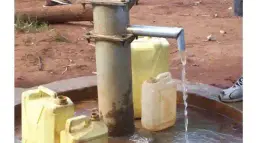Half of the boreholes in Harare’s western and northern districts are contaminated with human waste, the City of Harare epidemiology and disease control officer, Dr Michael Vere, has said.
Harare’s western district covers suburbs such as Highfield, Glen Norah, Glen View, Mbare, Dzivaresekwa, Budiriro, Kuwadzana and Kambuzuma.
The northern district covers Borrowdale, Glen Lorne, Glenwood Park, Newlands, Mabelreign, Highlands, Mabvuku, Tafara, Hatcliffe and Waterfalls.
Vere told The Sunday – that water samples from boreholes in these areas showed traces of E. coli bacteria, which can cause water-borne diseases like typhoid and cholera.
Harare residents heavily rely on boreholes due to erratic municipal water supply. Said Vere:
As Harare City Council, we routinely do water quality monitoring in targeted areas where there will be cases of cholera and typhoid.
Through our monitoring programme, we have found out that 50 per cent of boreholes in the western and northern districts are contaminated with sewer and human waste.
The discovery comes at a time when Harare was battling to contain a cholera outbreak directly linked to water shortages.
Vere said Harare and Chitungwiza require 1 200 megalitres of potable water a day but current water production is around 300 megalitres, a quarter of what is needed. He said:
Harare and surrounding areas like Chitungwiza need about 1 200 megalitres of water per day, but we are only able to produce 300 megalitres per day.
We have, however, decommissioned a few boreholes but not all of them because of the water challenges we are having in Harare.
To make the borehole water safe for human consumption, the local authority is doing inline chlorination where it puts chlorine in the boreholes so that the water gets chlorinated.
Medical and Dental Private Practitioners of Zimbabwe Association president Dr Johannes Marisa said there was a need to replace Harare’s water and sewer pipes.
Harare Residents Trust executive director, Precious Shumba, said underground water and sewer pipes need to be upgraded to cope with a ballooning population. He said:
They are rusty, sand-blocked and leaking in most weak areas resulting in underground water being heavily polluted.
The observations and findings of the City Health Department on the contamination of 50 per cent of borehole water are on point. They reflect the real situation on the ground.
The sizes of the pipes need to be upgraded to reflect the increase in population and the illegal settlements.
Plugging the leakages and illegal connections along the water distribution network is the first step in increasing the amount of water reaching houses connected to the water supply system.
In 2021, it was reported that 62% of Harare’s treated water was going to waste or was being used without being paid for.
SOURCE : PINDULA









